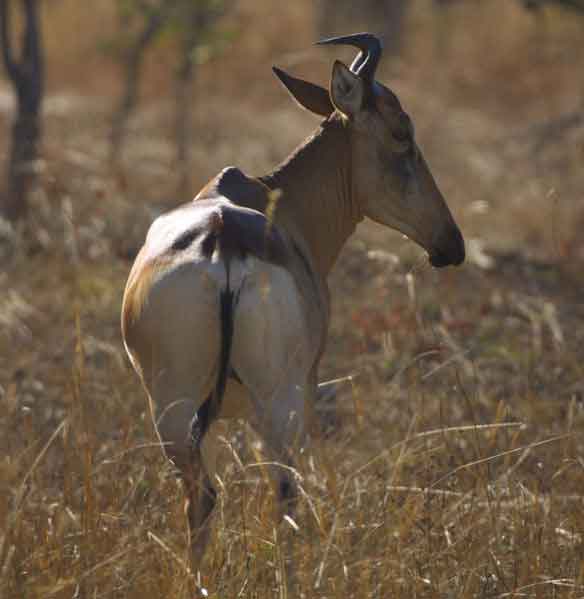
Alcelaphus lichtensteinii (*)
Superregnum: Eukaryota
Regnum: Animalia
Subregnum: Eumetazoa
Cladus: Bilateria
Cladus: Nephrozoa
Superphylum: Deuterostomia
Phylum: Chordata
Cladus: Craniata
Subphylum: Vertebrata
Infraphylum: Gnathostomata
Superclassis: Tetrapoda
Cladus: Reptiliomorpha
Cladus: Amniota
Cladus: Synapsida
Cladus: Eupelycosauria
Cladus: Sphenacodontia
Cladus: Sphenacodontoidea
OrdoTherapsida
Cladus: Theriodontia
Subordo: Cynodontia
Cladus: Mammaliaformes
Classis: Mammalia
Subclassis: Trechnotheria
Infraclassis: Zatheria
Supercohort: Theria
Cohort: Eutheria
Cohort: Placentalia
Cladus: Boreoeutheria
Superordo: Laurasiatheria
Ordo: Artiodactyla
Subordo: Ruminantia
Familia: Bovidae
Subfamilia: Alcelaphinae
Genus: Alcelaphus
Species: Alcelaphus lichtensteinii
Name
Alcelaphus lichtensteinii Peters, 1849
Type locality: Mozambique, Tette
Synonyms
Sigmoceros lichtensteinii (Peters, 1849)
Alcelaphus buselaphus lichtensteinii (Peters, 1849)
Bubalis lichtensteinii
References
Alcelaphus lichtensteinii in Mammal Species of the World.
Wilson, Don E. & Reeder, DeeAnn M. (Editors) 2005. Mammal Species of the World – A Taxonomic and Geographic Reference. Third edition. ISBN 0-8018-8221-4.
IUCN: Alcelaphus buselaphus lichtensteinii (Peters, 1849) (Least Concern)
Spenerschen Zeitung, 23 December 1849, p. unknown; reprinted in 1912 in Gesellschaft Natuurforschender Freunde zu Berlin for 1839-59
Wilson, D.E. & Reeder, D.M. (eds.) 2005. Mammal Species of the World: a taxonomic and geographic reference. 3rd edition. The Johns Hopkins University Press: Baltimore. 2 volumes. 2142 pp. ISBN 978-0-8018-8221-0. Reference page.
Vernacular names
English: Lichtenstein's Hartebeest
español: Alcéfalo de Lichtenstein
magyar: Lichtenstein-tehénantilop
polski: Bawolec Lichtensteina, Konzi
Lichtenstein's hartebeest (Alcelaphus buselaphus lichtensteinii)[2] is a subspecies of the hartebeest antelope that dwells in savannahs and floodplains of Southeastern[3]-Central Africa. It is sometimes classified as a unique species Sigmoceros lichtensteinii.
It derives its name from zoologist Martin Lichtenstein.
Description
It typically stands about 1.25 m (4.1 ft) at the shoulder and have a mass of around 150 kg (330 lb). It has a red-brown colour, which is lighter on the underbelly. The horns found on both sexes appear from the side to be shaped like the letter 'S', and appear from the front to be shaped like the letter 'O' with its upper portions missing. The horns are slightly ridged and reach over 0.5 m (1.6 ft) in length.
Behavior
They live on areas where they eat grasses. They are diurnal (active in the day). They gather in herds of five to 15 females and calves with a single male, which leads them. The male stands sentry duty on termite mounds and the like. Males hold large territories, which they mark by digging up soil with their horns around the borders. Lichtenstein's hartebeest have good eyesight but a poor sense of smell. Their main sounds are a bellow and a sneeze-snort sound.
They travel in herds. Herds are mainly kept between 1-10 individuals (89% of all LH in Tanzania have been within 1-10 animals. The herd may be composed of more than 10 individuals but it is seldom. (Booth 1985). It is noted that the highest number of Lichtenstein's Hartebeest congregating together occur in August/September. The exact reason is unknown however this is primarily when most calves are born. Add in local migration from other herds and it may a form of anti predator grouping to protect newborn calves. However, Bachelor males are often found alone countering the herd mentality (Dowsett 1966; Wilson 1966; Rodgers 1977). Bachelor bulls do not establish territories while solitary bulls will exclude others from their domain (Dowsett 1966). The ratio of male to female LH is 1:2.37.
Lichtenstein's Hartebeest are very territorial mammals and there is no overlap in territories between bulls. The rutting period (breeding season) runs typically from mid October to January, although slight variations exist between different locations (Dowsett 1966). Bachelor bulls will often challenge alpha bulls until the point of complete exhaustion to take over the related female LHs. There are numerous stereotyped behaviour patterns in the repertoire of the genus Alcephalus that are directly associated with territorial defence (von Richter 1972). Amongst these, pawing and homing the earth are the most conspicuous. In Zimbabwe the most conspicuous body movements were the 'head-to-flank', in which the head is rubbed against the shoulder, and a 'head-flagging' movement in which the hartebeest shook its head up and down vigorously when alarmed. Hartebeests mark their territory by forming dung piles in their respective territories.
References
IUCN SSC Antelope Specialist Group (2008). "Alcelaphus buselaphus ssp. lichtensteinii". IUCN Red List of Threatened Species. 2008. Retrieved 18 January 2009. Database entry includes a brief justification of why this species is of least concern
Wilson, Don E. & Reeder, DeeAnn M. (editors). 2005. Mammal Species of the World. A Taxonomic and Geographic Reference (3rd ed), Johns Hopkins University Press, 2,142 pp. Available online
Selous, F. C. (2011). "XXV". Travel and Adventure in South-East Africa. New York: Cambridge University Press. p. 445. ISBN 978-1108031165.
Retrieved from "http://en.wikipedia.org/"
All text is available under the terms of the GNU Free Documentation License

